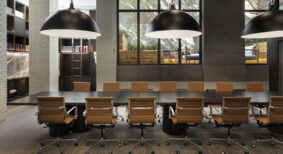Canadian firms are well-regarded and sought after for their design expertise around the world. Working with a multicultural design team on international projects is both interesting and rewarding; however, it can present challenges on many fronts, from design coordination and language barriers to bigger challenges with sourcing of material and construction expertise.
Depending on the location of the project or design team, simple coordination can be made challenging due to time difference or a different work week. The work week in Saudi Arabia, for example, is Saturday to Wednesday, leaving only a three day overlap with the work week in Canada. When coupled with the eight-hour time difference, the opportunity for telephone correspondence and direct communication becomes even more limited. This leads to most correspondence being via e-mail and early morning or weekend Skype meetings. Having limited opportunity for communication puts more focus on effective communication and well-planned meetings. If an opportunity to obtain clarification on a building or design feature is missed during a meeting, it may be a few days before correspondence can happen again, leading to delays in the design or review process.
Commonly, the business language on international projects is English; however, it may not be the first language of other members of the design team. This can lead to miscommunication or interpretative difficulties. Understanding how to communicate in a clear and simple fashion can reduce such difficulties and allow for better collaboration between all parties involved in a project.
Cultural factors need to be taken into consideration. While challenging, the experience can lead to great opportunities to learn design approaches from other parts of the world, and often leads to a high-bred design solutions based on a combination of international design approaches.
In the absence of a local design standard or building regulation, local authorities often adopt North American design standards – such as the International Building Code – for design guidance. In addition, international companies like hotel chains frequently require buildings, no matter the location, to comply with North American design standards in addition to local standards. Similarly, Canadian embassy and chancery buildings abroad are designed in accordance with the National Building Code of Canada and local building standards. Where multiple codes and standards are enforced, conflict can arise between standards in terms of how to approach fire and life safety. If not managed properly, this can lead to over design and increased project cost. Early discussions with local authorities and clients can help.
Design standards are based around materials and products freely available in North America or the country of origin. Such materials and products are listed in accordance with relevant Underwriters Limited (UL) standards or approving body. When working in countries in the Middle East or North Africa, procurement of the appropriately listed materials can present construction scheduling difficulties due to lead time and, often, listed materials come at a premium cost. Designers should attain information on locally available materials and construction expertise before specifying materials or design options. If early investigation is not conducted, it can lead to construction delays, excessive cost or redesign during construction.
Each international project brings new experiences and challenges, whether working on a project located in a country not worked in before or working with a design team from a different culture. Before pursuing international work, it is critical that firms assess the risk associated with a project, including payment terms, staffing resources and potential political unrest or conflict in the region. It can take many months or even years to attain full payment for work, and political unrest or conflict has led to cancellation of projects and non-payment.
Jack Keays, P.Eng., is a project engineer at Sereca Larden Muniak Consulting Inc. He holds a master’s degree in fire safety engineering and has more than six years of both national and international experience. He can be reached at jkeays@serecafire.com.







